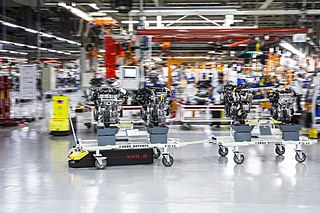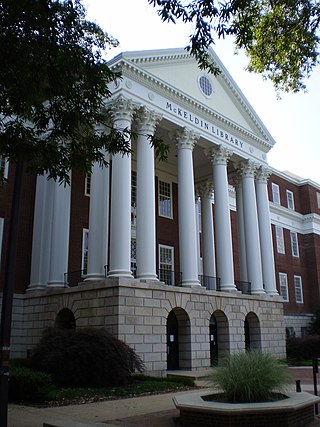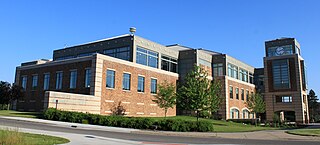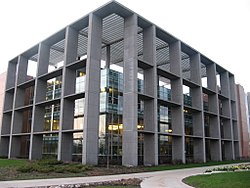Information retrieval (IR) in computing and information science is the process of obtaining information system resources that are relevant to an information need from a collection of those resources. Searches can be based on full-text or other content-based indexing. Information retrieval is the science of searching for information in a document, searching for documents themselves, and also searching for the metadata that describes data, and for databases of texts, images or sounds.

Logistics automation is the application of computer software or automated machinery to improve the efficiency of logistics operations. Typically this refers to operations within a warehouse or distribution center, with broader tasks undertaken by supply chain engineering systems and enterprise resource planning systems.

The Joseph Regenstein Library, often referred to by students as "The Reg," is the main library of the University of Chicago, named after industrialist and philanthropist Joseph Regenstein. It is one of the largest repositories of books in the world and is noted for its brutalist architecture.

In computer storage, a tape library, sometimes called a tape silo, tape robot or tape jukebox, is a storage device that contains one or more tape drives, a number of slots to hold tape cartridges, a barcode reader to identify tape cartridges and an automated method for loading tapes. Additionally, the area where tapes that are NOT currently in a silo are stored is also called a tape library. Tape libraries can contain millions of tapes.

An automated guided vehicle (AGV), different from an autonomous mobile robot (AMR), is a portable robot that follows along marked long lines or wires on the floor, or uses radio waves, vision cameras, magnets, or lasers for navigation. They are most often used in industrial applications to transport heavy materials around a large industrial building, such as a factory or warehouse. Application of the automatic guided vehicle broadened during the late 20th century.

The Rocco A. Petrone Launch Control Center is a four-story building at NASA's Kennedy Space Center on Merritt Island, Florida, used to manage launches of launch vehicles from Kennedy Space Center Launch Complex 39. Attached to the southeast corner of the Vehicle Assembly Building, the LCC contains offices; telemetry, tracking, and instrumentation equipment; and firing rooms.
The Lied Library building is located on the University of Nevada's Las Vegas (UNLV) campus in Paradise, Nevada. At 5 stories high and 302,000 square feet (28,100 m2), it is the largest building on the campus and the Architect of Record was Welles Pugsley Architects. It first opened on January 8, 2001. UNLV Libraries was established in 1957 and include the Lied Library that opened in 2001. Other campus libraries are the Architecture Studies Library, the Health Sciences Library, the Teacher Development & Resources Library, and the UNLV Music Library. UNLV Libraries has a collection of more than one million volumes, access to over 20,000 online and print journals, and more than 2 million additional resources of various media such as microfilm, DVDs, and government publications.

An automated storage and retrieval system consists of a variety of computer-controlled systems for automatically placing and retrieving loads from defined storage locations. Automated storage and retrieval systems (AS/RS) are typically used in applications where:

The University of Maryland Libraries is the largest university library in the Washington, D.C. – Baltimore area. The university's library system includes eight libraries: six are located on the College Park campus, while the Severn Library, an off-site storage facility, is located just outside campus, and the Priddy Library is located on the University System of Maryland satellite campus in Shady Grove.
The University of British Columbia Library is the library system of the University of British Columbia (UBC). The library is one of the 124 members of the Association of Research Libraries (ARL). In 2017, UBC Library ranked 29th among members of the ARL for the number of volumes in library, making it the third largest Canadian academic library after the University of Toronto and the University of Alberta. However, UBC Library ranked 23rd for the titles held and second in Canada, and had a materials expenditures of $13.8 million, placing it 44th.

Material handling equipment (MHE) is mechanical equipment used for the movement, storage, control, and protection of materials, goods and products throughout the process of manufacturing, distribution, consumption, and disposal. The different types of equipment can be classified into four major categories: transport equipment, positioning equipment, unit load formation equipment, and storage equipment.

The Merrill–Cazier Library is an academic library serving the students of Utah State University and the community of Logan, Utah.

The Macquarie University Library is the largest academic library in Northern Sydney. The library holds over 1.8 million print and electronic items, including books, journals, newspapers, reports, conference proceedings, working papers, maps, Macquarie postgraduate theses, computer software, multimedia, microfilm, microfiche and additional non-print resources.

The William F. Ekstrom Library is the main branch of the University of Louisville Libraries system. Located on the university's Belknap Campus in Louisville, Kentucky, Ekstrom Library contains collections in the humanities, sciences, and social sciences. The University of Louisville Libraries is a member of the Association of Research Libraries (ARL) and, along with Ekstrom, includes libraries for Art, Health Sciences, Law, and Music, as well as the Archives and Special Collections. The University of Louisville Libraries hold approximately 2.2 million print volumes, subscribe to several thousand serials, and provide full-text electronic access to approximately 74,000 journals. Ekstrom is a Federal Depository Library and houses the largest selective government document collection in Kentucky.

The Joe and Rika Mansueto Library is the newest library of the University of Chicago, named after alumni Joe Mansueto and Rika Mansueto. The library has a capacity of 3.5 million volumes under an elliptical dome. It was designed by Helmut Jahn.

The Bruce T. Halle Library, often referred to as Halle Library, is the sole library on the Eastern Michigan University campus. It houses one of the largest collections of children's literature in the United States.
The Colby College Libraries are the libraries that support Colby College in Waterville, Maine. The libraries provide access to a merged catalog of more than eight million items via the Colby-Bates-Bowdoin consortium of libraries and MaineCat, with daily courier service from other libraries in Maine. Twelve professional librarians provide research assistance to students, faculty, and outside researchers. Instruction in the use of the library and its research materials is offered throughout the curriculum, from an introduction in beginning English classes to in-depth subject searching using sophisticated tools in upper-level classes.

UTS Library provides support for teaching, learning, and research needs of the students and staff of the University of Technology Sydney (UTS). The building is located in Building 2 next to the UTS Tower and opposite Central Park on Broadway, across Levels 5 - 9 within UTS Central. The main entrance to the new UTS Library is on Level 7 of UTS Central. It is accessible by a double helix staircase, escalators, or lifts. UTS Library includes study spaces, academic support, and services across various levels of UTS Central.

An automated (car) parking system (APS) is a mechanical system designed to minimize the area and/or volume required for parking cars. Like a multi-story parking garage, an APS provides parking for cars on multiple levels stacked vertically to maximize the number of parking spaces while minimizing land usage. The APS, however, utilizes a mechanical system to transport cars to and from parking spaces in order to eliminate much of the space wasted in a multi-story parking garage. While a multi-story parking garage is similar to multiple parking lots stacked vertically, an APS is more similar to an automated storage and retrieval system for cars. The paternoster is an example of one of the earliest and most common types of APS.

The James B. Hunt Jr. Library is the second main library of North Carolina State University (NCSU) and is located on the university's Centennial Campus. The $115 million facility opened in January 2013 and is best known for its architecture and technological integration, including a large robotic book storage and retrieval system which houses most of the university's engineering, textiles, and hard sciences collections. The library is named after James Baxter "Jim" Hunt Jr., the four-term 69th and 71st governor of North Carolina. NCSU Libraries is part of the Triangle Research Libraries Network (TRLN), which shares books between North Carolina State University, Duke University, The University of North Carolina at Chapel Hill, and North Carolina Central University.


















